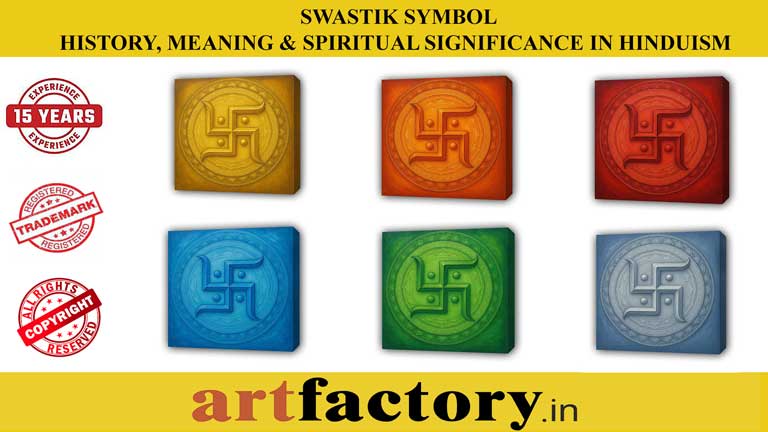
Swastik Symbol: History, Meaning & Spiritual Significance in Hinduism
The Swastik (or Swastika) is one of the most sacred and powerful symbols in Hinduism, with deep spiritual, cultural, and philosophical meaning. Often seen during religious rituals, festivals, and on entrances of homes and temples, this ancient symbol has stood the test of time, radiating prosperity, peace, protection, and divine energy.
In this blog, we will explore the origin, history, meaning, and relevance of the Swastik, especially in spiritual practices and daily life. We'll also answer the most common questions people ask about the Swastik to help you understand its true power and purpose.
What is the Swastik Symbol?
The word "Swastik" comes from the Sanskrit word "svastika", meaning "well-being," "good fortune," or "auspiciousness." It is composed of:
"Su" meaning good
"Asti" meaning to be or to exist
"Ka" as a suffix
Thus, Swastik literally means “that which is associated with well-being”.
History of the Swastik
The Swastik is one of the oldest symbols in human history, with roots dating back over 12,000 years, appearing in ancient Indian scriptures, pottery, and architecture. It has been found in:
Indus Valley Civilization
Vedic literature
Ancient temples and homes
Buddhist and Jain traditions
Even in ancient civilizations across Greece, China, and Native America
Despite its later misuse in the 20th century, in Hinduism, Swastik has always been a symbol of light, harmony, and eternal truth.
Meaning and Symbolism of Swastik in Hinduism
In Hindu tradition, the Swastik holds multi-dimensional meaning:
✅ Auspiciousness: Used at the start of any puja, marriage, or housewarming ceremony.
✅ Divine Blessings: Represents Lord Ganesha, the remover of obstacles.
✅ Four Directions: The four arms stand for North, South, East, and West, symbolizing balance and stability.
✅ Four Vedas: Represents the knowledge and structure of life.
✅ Cycle of Life: Indicates the eternal nature of time — creation, preservation, and destruction.
There are two primary types of Swastik:
Right-facing (clockwise) – used in Hinduism for prosperity and protection.
Left-facing (counter-clockwise) – used in some tantric rituals but is generally avoided in mainstream practices.
Swastik in Spiritualism
The Swastik is a powerful energy symbol, often drawn with kumkum, turmeric, chandan, or sindoor during spiritual practices. It is believed to:
Invite positive vibrations
Create a protective spiritual shield
Enhance meditative energy
Align the space with cosmic order
Swastik for Prosperity, Peace & Divine Energy
The Swastik is directly associated with abundance and well-being. It is often used in:
Homes and businesses for financial growth
New ventures to ensure success
Festivals like Diwali, especially when combined with footprints of Goddess Lakshmi
It is believed that drawing a Swastik near your main door, locker, or workplace altar helps:
Attract wealth and success
Bring inner peace
Remove financial blockages
Strengthen your connection to divine energy
Frequently Asked Questions (FAQs) About the Swastik Symbol
Q1. What does the Swastik symbolize in Hinduism?
A: It symbolizes good luck, protection, divine blessings, and the cyclical nature of life. It's a sacred symbol used to begin any auspicious task.
Q2. Is Swastik used only in Hinduism?
A: No. The Swastik is also sacred in Jainism and Buddhism, and has appeared in ancient Greek, Chinese, and Native American cultures.
Q3. What’s the difference between the Swastik and the Nazi symbol?
A: The Nazi swastika is left-facing and tilted, which is a misappropriation of the original right-facing sacred Swastik used in Indian spiritual traditions. The meanings are completely different.
Q4. Where should I place a Swastik symbol in my home?
A: Place it near your main entrance, pooja room, or above your temple. It brings positive energy and protects your home from negativity.
Q5. Can I wear the Swastik as a pendant or on clothing?
A: Yes, many people wear Swastik pendants or use it in jewelry or clothing as a personal energy enhancer and protective symbol.
Conclusion
The Swastik is much more than just a symbol—it is a timeless emblem of peace, prosperity, protection, and spiritual harmony. With deep roots in Hindu philosophy and spirituality, it serves as a powerful reminder of the divine presence in all aspects of life.
Whether used in rituals, drawn on walls, or worn as jewelry, the Swastik helps us stay aligned with the universal forces of positivity and truth.

Comments : (1)
Seema Singh
2 days ago